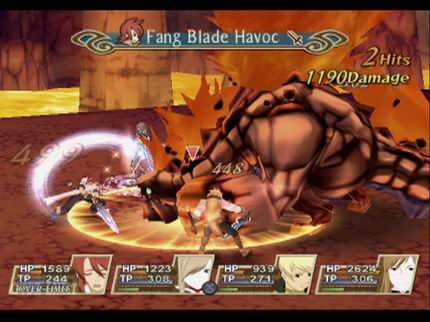Like most Tales games, Abyss takes place in a unique world with few obvious connections to the previous adventures. You take on the role of Luke fon Fabre, a spoiled young duke who was raised in isolation after being briefly kidnapped during his teenage years. His sheltered life comes to an abrupt end when a girl named Tear storms his manor, initiating a hyper resonance effect when she touches him. Transported halfway across the world, the naive Luke has to grow up fast to make sense of his strange new predicament. Caught between warring empires and an ancient religion, Luke will find that the fate of the world's future depends on his actions. He wouldn't be an RPG hero otherwise.
Fresh Fighting
From the start, Tales of the Abyss looks quite a lot like its esteemed predecessor. The graphical style is similar and the angled overhead camera should be familiar. The differences come in the little details, which Abyss has in abundance.

The battle system, for examples, starts with the basic Symphonia template, with you and three AI-controlled party members running around and slashing the beasties in real-time. However, lots of little additions add up. For starters, you're no longer constrained to a 2D plane. Hold down a button and you'll be able to run freely around the enemies, all the better to setup a devastating rear attack. Another new feature is the ability to add party members' abilities to D-pad shortcuts. So, you can run in, activate your teammate's attacks at just the right times, and thus achieve much higher-scoring combos. (It's important to be flashy, as the high scores you earn in battle can be used to purchase crazy-cool items on your second play-through.)
Perhaps the biggest addition to combat, though, is the fonon field system. In Abyss' world, fonons are the magical particles that make up everything, and you can harness their power on the battlefield by casting circular fields that appear on the ground. Each field is aligned with one of six elements, and this affiliation will affect the properties of spells cast within it. For example, you can create a fire-based field where an enemy is standing, wait for it to charge up, and then cast a fire-based attack, which will morph into a much stronger spell, thanks to the field. However, any enemy standing in a field can use it for its own purposes, so you'll want to be careful about what sorts of fields you throw down around monsters.
All told, Abyss' battle system looks to be a nice little evolution of Symphonia's, so if you liked that game's encounters you'll feel right at home here. Four-player support is in as well, so if the partner AI isn't cutting it for you, invite some friends over.





